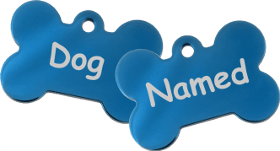1690s Dog Names - Page 2
Updated: July 02, 2024
Engulf yourself in the rich tapestry of history as you explore this unique collection of canine appellations. Our list transports you back to the 1690s, a time of exploration, scientific discovery and cultural shifts. These names, popular in the 17th century, offer an intriguing blend of elegance, charm, and historical significance.
Whether you're a history enthusiast, a lover of vintage, or simply seeking something distinct for your furry friend, these names provide an unparalleled choice. With inspirations drawn from historical figures, literature, and ancient cultures of the 17th century, each name holds a story, a connection to a time long past. Imbued with character and time-honored tradition, these names are a delightful diversion from the conventional, modern dog names.
So, let's delve into the past and bring a piece of history to the present with this fascinating list of dog names. Be prepared to uncover a name that not only resonates with your dog’s personality but also bears the weight of historical significance. Happy exploring!
| Name | Reason to Choose |
|---|---|
| Dove | It's a nod to the symbol of peace in the 1690s |
| Drake | Sir Francis Drake was a well-known figure |
| Duke | Nobility titles were often used as names |
| Elder | Respect for elders was highly valued |
| Fable | It's a nod to the oral storytelling traditions of the time |
| Fallow | A term from farming, a major part of life |
| Farthing | Named after the smallest coin in the 1690s |
| Fennel | A popular herb in the 1690s |
| Fervor | Symbolizes the religious zeal of the period |
| Fletcher | People in this era often made their own arrows |
| Forge | It's a nod to the blacksmiths of the 1690s |
| Friar | Religious figures were highly respected |
| Gable | Architecture of the period often featured gabled roofs |
| Gentry | Referring to the social class |
| Goodwin | A common surname of the era |
| Grain | Grains were a staple food source |
| Grist | Taken from a term for grains that are ready to be ground; a nod to the agricultural lifestyle |
| Grove | Refers to the importance of forests for resources |
| Guild | Guilds played a major role in business and trade |
| Hamlet | Shakespeare's works were popular |
| Harrow | Agricultural tools were part of everyday life |
| Harvest | Autumn was a significant time for farming communities |
| Hawthorne | For the native trees in England and America |
| Hearth | The hearth was the center of the home |
| Herald | It's a tribute to the heralds who announced important news in the 1690s |
| Honor | Honor was a highly valued virtue |
| Hops | Essential ingredient in beer production |
| Humble | It reflects the modesty of the Puritan lifestyle |
| Jest | Named for the jesters and entertainers of the 1690s |
| Jubal | Biblical names were popular |
|
Suggest:
|
Submitted!
|
| 1 2 3 4 | |
1690s Maritime Dog Names
| Name | Description |
|---|---|
| Anchor | A key part of any maritime voyage |
| Astrolabe | Named after the ancient device used to measure latitude at sea |
| Binnacle | A ship's stand for compasses and other instruments |
| Caliber | Refers to the internal diameter of a gun barrel; common term in naval warfare |
| Cannon | Central to naval warfare during the 1690s |
| Capstan | A vertical-axled rotating machine developed for use on sailing ships to apply force to ropes, cables, and hawsers |
| Columbus | After the explorer Christopher Columbus |
| Compass | A vital tool for maritime navigation |
| Cook | Honors James Cook, a British explorer and captain in the Royal Navy |
| Cutlass | A short sword or saber, typically used on ships |
| Davits | Refers to the crane-like devices on a ship, used for supporting, raising, and lowering boats |
| Drake | Might refer to famous English sea captain Sir Francis Drake |
| Dreadnought | An early term for a powerful warship |
| Frigate | Named after the warship type common in the 17th century |
| Galleon | Signifies a large multi-deck ship used primarily by European states from the 16th to 18th centuries |
| Hawke | Edward Hawke was a famous British admiral in the 18th century |
| Keel | Refers to the main structural component of a ship |
| Lanyard | A rope used on a ship to hold or secure something |
| Latitude | Recognizes the importance of navigation at sea |
| Longitude | Reflects the nautical significance of geographical positioning |
| Magellan | Refers to Ferdinand Magellan, the Portuguese explorer |
| Marlin | After the marlin spike, a tool used in marine ropework |
| Nelson | Horatio Nelson was a prominent British naval commander |
| Raleigh | An homage to Sir Walter Raleigh, an English adventurer and writer |
| Sloop | After the single-mast sailing vessel |
|
Suggest:
|
Submitted!
|
1690s French Dog Names
| Name | Description |
|---|---|
| Absolut | Reflects the absolute monarchy of 1690s France |
| Beauvoir | Inspired by Simone de Beauvoir, a famous French writer and philosopher |
| Bourbon | Signifies the House of Bourbon, the ruling dynasty of the 1690s |
| Chambord | Named after the Château de Chambord, reflecting the architectural grandeur of the time |
| Champagne | Named after the world-renowned French wine |
| Chateau | French for 'castle', a common sight in 1690s France |
| Danton | Named after Georges Danton, a leading figure in the early stages of the French Revolution |
| Dauphin | French for 'dolphin', a term also used for the heir apparent to the throne |
| Fronde | Represents the civil wars that occurred in the mid-17th century in France |
| Huguenot | Refers to the French Protestants who were prevalent during this era |
| Jansenist | Refers to the followers of the theological movement within Catholicism |
| Lace | Symbolizes the lace-making industry that was thriving in France during the 1690s |
| Lafayette | Named after Marquis de Lafayette, a famous French aristocrat |
| Louis | Named after King Louis XIV who reigned during this time period |
| Marquis | Reflects the prevalent aristocracy in France during the 1690s |
| Moliere | Inspired by the famous French playwright and actor |
| Montaigne | Named after Michel de Montaigne, a significant figure in the French Renaissance |
| Perrault | Named after Charles Perrault, a French author well-known in the 1690s |
| Regent | Symbolizes the regency periods that were common during this era |
| Rococo | Denotes the art style that was emerging in late 17th century France |
| Roi | French for 'king', echoing the monarchy led society of the time |
| Rousseau | Inspired by the French philosopher Jean-Jacques Rousseau |
| Versace | Named after the fashion brand, symbolizes the fashion-forward culture of France |
| Versailles | Symbolizes the royal palace, a significant monument in 1690s France |
| Voltaire | Inspired by the famous French philosopher and writer |
|
Suggest:
|
Submitted!
|
1690s Historical Figure Dog Names
| Name | Description |
|---|---|
| Bach | In memory of Johann Sebastian Bach, a renowned German composer |
| Berkeley | After George Berkeley, an Irish philosopher |
| Defoe | For Daniel Defoe, a prolific and versatile writer |
| Descartes | A nod to René Descartes, a French philosopher, mathematician, and scientist |
| Diderot | Honoring Denis Diderot, a French philosopher, art critic, and writer |
| Gibbon | For Edward Gibbon, an English historian |
| Handel | Georg Friedrich Handel, a composer of the Baroque era |
| Haydn | For Joseph Haydn, a prominent and prolific composer of the classical period |
| Hobbes | In memory of Thomas Hobbes, an English philosopher |
| Hume | David Hume, a Scottish Enlightenment philosopher, gets a nod |
| Kant | Honors Immanuel Kant, a German philosopher |
| Leibniz | Tribute to Gottfried Wilhelm Leibniz, co-inventor of calculus |
| Locke | Honors John Locke, a prominent philosopher during the 1690s |
| Moliere | After Moliere, a French playwright and actor |
| Montesquieu | For Montesquieu, a French lawyer and philosopher |
| Mozart | Pays tribute to Wolfgang Amadeus Mozart, a prolific and influential composer of the classical era |
| Newton | After Sir Isaac Newton, a key figure in the scientific revolution of the 17th century |
| Pepys | Named after Samuel Pepys, an English naval administrator and Member of Parliament |
| Purcell | A nod to Henry Purcell, a famous English composer |
| Rousseau | Salutes Jean-Jacques Rousseau, a philosopher, writer, and composer |
| Spinoza | For Baruch Spinoza, a Dutch philosopher of Sephardi Portuguese origin |
| Swift | After Jonathan Swift, the author of Gulliver's Travels |
| Vivaldi | Salutes Antonio Vivaldi, an influential composer in the late Baroque period |
| Voltaire | To honor Voltaire, a leading figure in the European Enlightenment |
| Wren | For Sir Christopher Wren, a famous architect of the time |
|
Suggest:
|
Submitted!
|
1690s Literary Dog Names
| Name | Description |
|---|---|
| Addison | Joseph Addison, a poet, playwright, and politician |
| Behn | Tribute to Aphra Behn, one of the first professional female writers |
| Blake | William Blake, an English poet, painter, and printmaker |
| Boswell | James Boswell, a biographer and diarist |
| Bunyan | A nod to John Bunyan, author of The Pilgrim's Progress |
| Burns | Robert Burns, also known familiarly as Rabbie Burns, the National Bard, Bard of Ayrshire and the Ploughman Poet |
| Coleridge | Samuel Taylor Coleridge, an English poet, literary critic, philosopher, and theologian |
| Congreve | After William Congreve, known for his plays and poems |
| Defoe | After Daniel Defoe, author of Robinson Crusoe |
| Dryden | John Dryden, poet, literary critic, translator, and playwright |
| Fielding | Inspired by Henry Fielding, novelist and playwright |
| Goldsmith | After Oliver Goldsmith, a novelist, playwright and poet |
| Johnson | Samuel Johnson, a poet, essayist, moralist, literary critic, biographer, editor, and lexicographer |
| Locke | Inspired by the philosopher John Locke |
| Marlowe | Christopher Marlowe, a contemporary of Shakespeare |
| Milton | Named after John Milton, a prominent English poet of the 17th century |
| Otway | Thomas Otway, a noted Restoration dramatist |
| Pepys | Named for Samuel Pepys, famous for his detailed diary |
| Pope | For Alexander Pope, a poet of the early 18th century |
| Smollett | Tobias Smollett, a Scottish poet and author |
| Spenser | Edmund Spenser, known for his epic poem The Faerie Queene |
| Sterne | Laurence Sterne, an Irish novelist and an Anglican clergyman |
| Swift | Jonathan Swift, a satirist of the period, lends his name to this canine |
| Walpole | Horace Walpole, an English writer, art historian and Whig politician |
| Wordsworth | William Wordsworth, an English Romantic poet |
|
Suggest:
|
Submitted!
|
1690s Royal Dog Names
| Name | Description |
|---|---|
| Baron | Baron is a rank of nobility, making it a fitting name for a royal dog |
| Castle | This name was inspired by the residences of the royal family |
| Coronet | This name was inspired by a small crown worn by nobles |
| Countess | This name was inspired by the title of a noblewoman |
| Crown | This name was inspired by the symbol of royalty |
| Duchess | Perfect for a female dog, this name reflects the titles used in the royal court |
| Duke | This name reflects a high ranking title in the nobility |
| Earl | This is a title of nobility used in several kingdoms |
| Empire | This name was inspired by the vast territories controlled by monarchs |
| Gentry | This name reflects the class of people next below the nobility |
| Jewel | This name is reminiscent of the precious gems that adorn royal crowns |
| Kingston | This name was inspired by the capital city of Jamaica, which was established in the 1690s |
| Knight | This name was inspired by the loyal protectors of the realm |
| Majesty | This name is a term of respect for monarchs |
| Monarch | This name is fitting for a dog belonging to rulers |
| Noble | This name implies dignity and high rank, suitable for a royal dog |
| Prince | This name was inspired by the title for the son of a monarch |
| Regal | This name exudes an air of nobility and majesty, fitting for a royal pet |
| Regent | This term refers to a ruler, ideal for a commanding dog |
| Scepter | This name was inspired by a symbol of royal authority |
| Sovereign | This name reflects the ultimate authority of the monarch |
| Stuart | This was the ruling house in England during the 1690s |
| Throne | A symbol of royal power and authority |
| Tiara | This name was inspired by the jewel-encrusted crowns worn by royalty |
| Victoria | Although Queen Victoria was from a later era, the name was still used in the 1690s |
|
Suggest:
|
Submitted!
|
User Submitted Images
There are currently no user submitted images for this page. This is your opportunity to be the first! Submit your photo below.
User Recommendations
There are currently no name recommendations for this page. This is your opportunity to be the first! Make your recommendation below.
Recently Updated
We would like to take this time to thank all of our visitors that make DogNamed.com the best dog naming resource on the web. Our site would not be where it is today without your suggestions, ratings, and photo submissions. So pat yourselves on the back for a job well done and keep up the good work! If you have any comments, suggestions, or ideas for the this page or any part of our site, don't hesitate to drop us a line on our Contact Page. Thank you! -The DogNamed Team




























